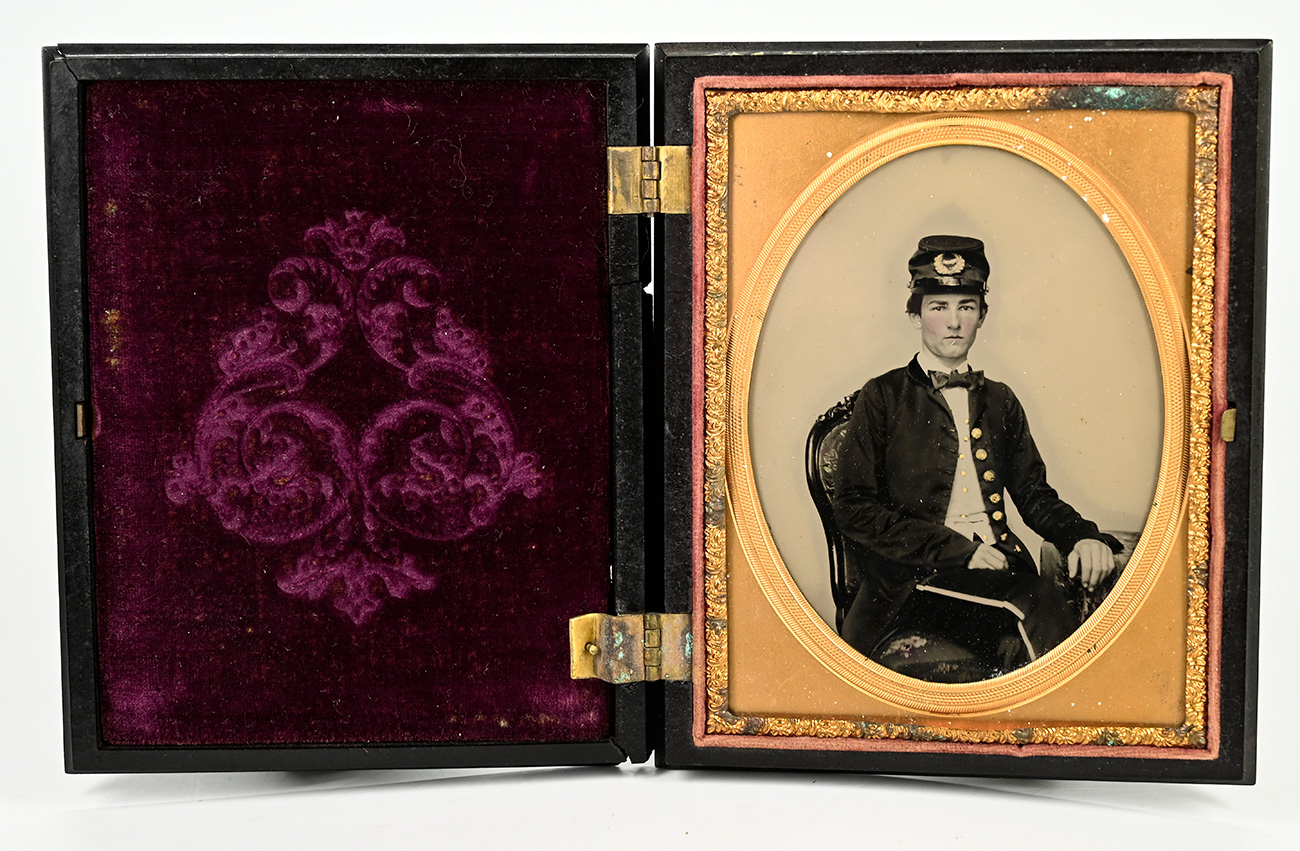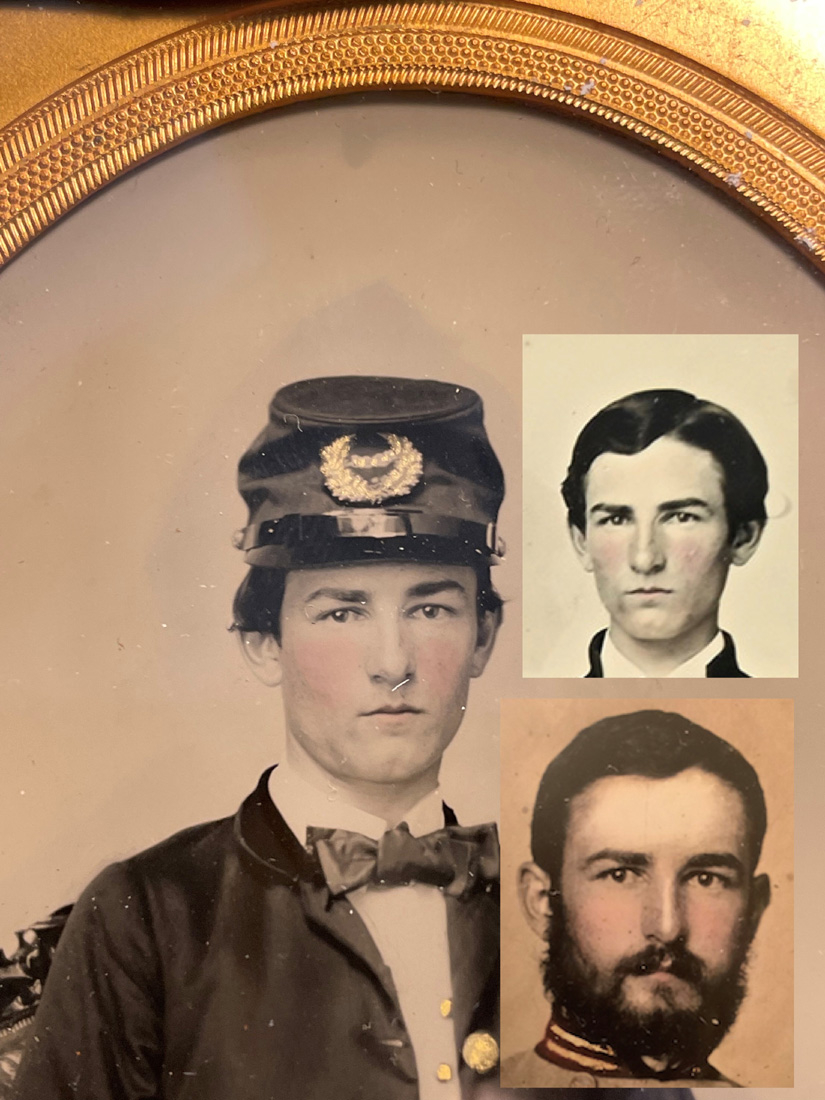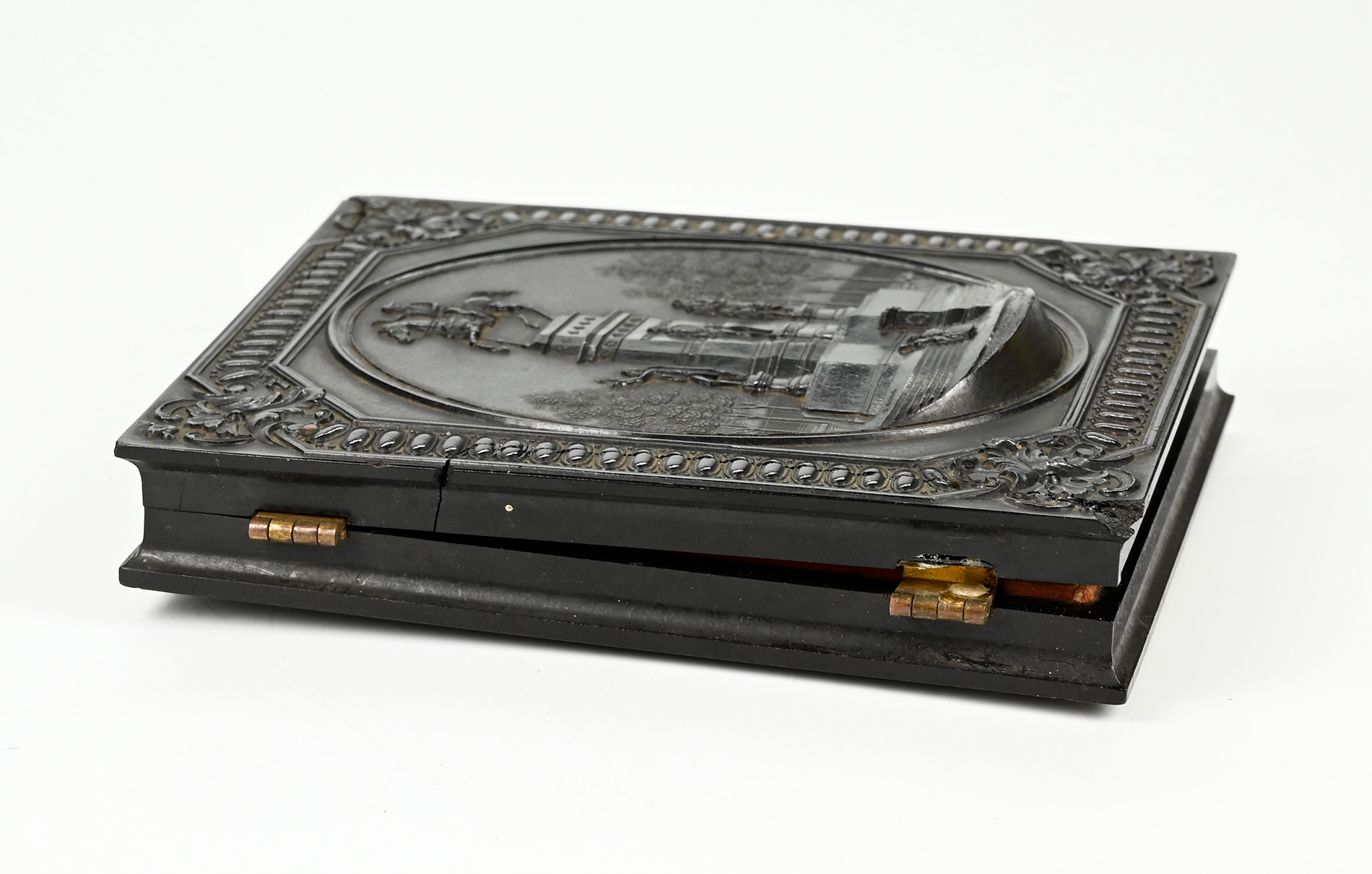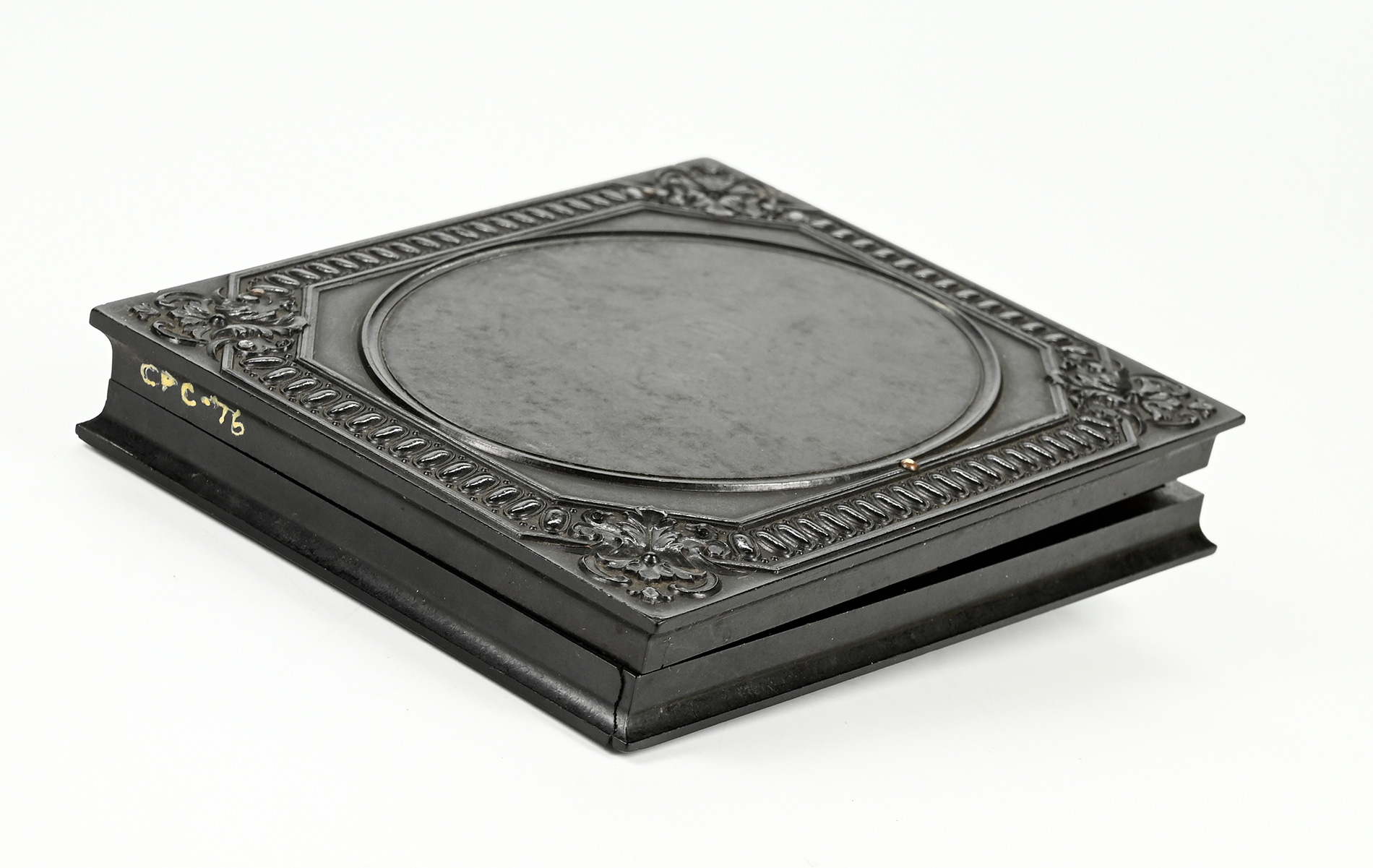site search
online catalog
CONFEDERATE CAPTAIN WILLIAM RICE JONES AS WEST POINT CADET CA. 1859; CITED FOR GALLANTRY AT GALVESTON; ASSISTANT CHIEF OF ARTILLERY IN TEXAS

Hover to zoom





$6,500.00 SOLD
Quantity Available: None
Item Code: 1138-1775
This quarter-plate ambrotype is housed in a very nice Richmond Washington monument thermoplastic case and comes from the collection of the late Virginia collector and dealer Bill Turner. The identification is based on a period note in an image of Jones with a fellow cadet that we offer separately, also from the Turner collection, and from other identified images.
William Rice Jones (Nov. 21, 1840 -1894) of Brunswick County, Virginia, was appointed to West Point with the backing of Congressman W.O. Goode, a relative, and entered the Academy in Summer 1857 at age 16. He is shown here seated in a two-thirds length view, wearing a cap, open frock coat disclosing a white vest, dark trousers with a seam stripe, and rests one arm on a table next to him. The uniform is the furlough uniform for West Point cadets: an officer’s style frock coat without insignia, dark trousers, and a forage cap showing a “USMA” inside a wreath on the front, reversed here by the ambrotype process. Cadet uniforms were decided by the USMA Superintendent and the Secretary of War, rather than through regular army and quartermaster channels. In the 1840s the furlough uniform used an 1839 Pattern forage cap with USMA in a wreath, embroidered on a band around the base of the cap. In the 1850s uniform changes were made at least once by Lee, and included updating headgear. In this case the cap is the late 1850s style forage cap and, rather than being on a separate band, the USMA/wreath is embroidered on a patch affixed to the front of the cap, like other contemporary insignia. By 1870 the cap was an updated chasseur style and the insignia included an Engineers’ castle with the “USMA.” Since cadets did not usually receive a furlough until completion of their second year, we would date the image to 1859 or 1860. Jones did not graduate from the Academy. After the secession of Virginia, he resigned April 22, 1861, and reached Richmond with a group of other cadets who had resigned and expected appointments in the Virginia military pending transfer to the Confederate States Army.
Jones summarized his Confederate service in a September 1865 application to President Johnson for amnesty:
“I entered the service of the State Va. on the first day of May 1861 and was continued with recruiting service till July following when I was appointed Cadet in the C.S. Army and ordered to N.C. In October following I was appointed Lt. of Artillery and remained in N.C. till May 1862 when I returned to Va. and was appointed Adjt. Of the 4th Va. Heavy Artillery, with the rank of First Lieut. In October 1862 I was ordered to Texas and remained there till the termination of the war.
When I reached Texas I was continued in various staff capacities till March 1863, when I was assigned to the command of a Heavy Battery at the mouth of the Brazos River, where I remained until November 1863, when I was assigned to the staff of Brig. Genl. J.E. Slaughter as Chief of Artillery. When Gen. Slaughter was Chief of Staff for Maj. Gen. Magruder I was Asst. Chief of Artillery for the latter. I accompanied Genl. Slaughter to the west and remained with him till the 28th Day of May 1865 when I left Brownsville for my home. I was Asst. Insp. Genl. On the staff of Genl. Slaughter and was paroled at Houston Texas July 5th 1865.
I have the honor to be
Very Respectfully
Your Obt Servt
William R. Jones
(late) Capt & A.I. Gen’l C.S.A.”
His compiled service records add some details, though records of similarly named soldiers have found their way into his file and vice versa. His appointment in the CS Army as Cadet was likely due to his age. One document lists him as a cadet in the corps of artillery and another in the engineers, likely reflecting service in fortifying the coast and countering Federal actions such as Burnside’s Coastal Expedition. His promotion to 2nd Lieutenant likely occurred in anticipation of his twenty-first birthday. His assignment to the 4th Va. Heavy Artillery in May 1862 naturally made use of his artillery training at West Point, though their first service was as infantry in Holmes Division as the end of the Seven Days Battles and Jones’s file includes praise for his knowledge of infantry tactics as well. Thereafter, however, they were posted at Chaffin’s Farm on the James River opposite Drewry’s Bluff and helped control a critical bend in the river in defense of Richmond.
Jones’ selection by Magruder for duty in Texas also made use of his artillery experience, first in plans to retake the port of Galveston and then to counter the U.S. blockading fleet along the Texas coast. In the battle on January 1, 1863, Jones seems to be one of three artillery lieutenants praised as behaving, “with remarkable gallantry during the engagement, each of them volunteering to take charge of guns and personally directing the fire after the officers originally in charge of them had been wounded.” His duties immediately after the battle likely involved the placement of guns to dissuade further Union landings. (In typically theatrical gesture, Magruder apparently deployed wood cannon to supplement his real ones.)
Jone’s field assignment in March 1863 gave him the rank of captain in Bates’ Regiment of Texas Volunteers, later designated the 13th Texas, nominally infantry, but containing all branches of service. They served along the Texas coast from Matagorda to Galveston. Jones’s company, eventually designated (the second) Company F, was one of two companies converted to heavy artillery and posted to defenses at the mouth of the Brazos River at Velasco.
Jones’s duty on the staff of Gen. Slaughter at the end of 1863 corresponds to that officer’s arrival in Texas, where he acted in several capacities for Magruder. One was as commander of the East Subdistrict of Texas, at which point Jones seems to have been Slaughter’s Chief of Artillery for the subdistrict and, by his own account, Assistant Chief of Artillery to Magruder while Slaughter was Magruder’s chief of staff. This might be understood to mean he was simply performing the same duty under a different title, but may mean his responsibilities expanded to include the entire District of Texas, which a May 1864 document in his file referring to him as “acting chief of artillery” might support.
During the last eight months or so of the war, Slaughter was in charge of the West Subdistrict of Texas. Jones refers to it as “accompanying Slaughtier to the west,” though the district seems to have covered more or less everything south of San Antonio. This gave Slaughter a a field force largely of cavalry, which diminished as the war sputtered out on the frontier, but which fought what many regard as the last battle of the Civil War: Palmito Ranch, fought May 12-13. Jones’s statement that he was Slaughter’s Assistant Inspector General until May 28, 1865, covers the battle, which was fought while surrender terms were being discussed by some commanders. Not only were the Confederate troops involved part of Slaughter’s overall command, Slaughter himself arrived toward the end of the fighting with reinforcements. If Jones was at his side, as seems likely, it perhaps seemed best not to mention it in an application for amnesty.
While Slaughter and others sought refuge in Mexico as the last Confederate forces dispersed, Jones stayed in Texas to be paroled and return home to Virginia, where he died at age 52 in 1894. He maintained his connections with Texas, however: he took a job managing the Callaghan ranch near San Antonio in the early 1870s and guided its expansion into a sprawling operation.
We show in the listing two identified images of Jones to establish the identification. The first is from the identified image of Jones with a companion that was also in Bill Turner’s collection. The second is from an image of him as a Confederate artillery captain and still held in a branch of the family. There is no doubt about the identification. As Sam noted, “look at the eyebrow.” [sr] [ph:M]
~~~~~~~~~~~~~~~~~~~~~~~~~~~~~~~~~~~
THIS ITEM, AS WITH ALL OTHER ITEMS AVAILABLE ON OUR WEB SITE,
MAY BE PURCHASED THROUGH OUR LAYAWAY PROGRAM.
CLICK HERE FOR OUR POLICIES AND TERMS.
THANK YOU!
Inquire About CONFEDERATE CAPTAIN WILLIAM RICE JONES AS WEST POINT CADET CA. 1859; CITED FOR GALLANTRY AT GALVESTON; ASSISTANT CHIEF OF ARTILLERY IN TEXAS
Most Popular
Historical Firearms Stolen From The National Civil War Museum In Harrisburg, Pa »
Theft From Gravesite Of Gen. John Reynolds »
Selection Of Unframed Prints By Don Troiani »
Fine Condition Brass Infantry Bugle Insignia »
Large English Bowie Knife With Sheath 1870’S – 1880’S »
Imported (Clauberg) Us Model 1860 Light Cavalry Officer's Saber »
featured item
1/4 PLATE THERMOPLASTIC CASE WITH AMBROTYPE OF WOMAN & TINTYPE OF 2/LT. BAKER 20TH PA. INFANTRY – THE GREAT RAILROAD STRIKE OF 1877
Left half of this hard case houses an ambrotype of a finely dressed woman. Her cheeks and forehead are tinted. The image is matted, framed, and under glass as is typical. The right side of the case holds an 1877 tintype image of S. Charles Baker in… (1221-53). Learn More »


